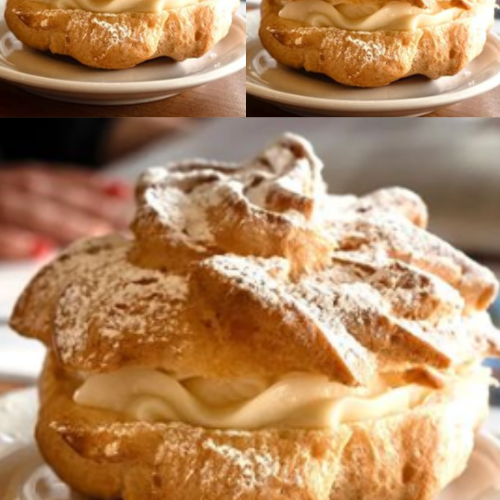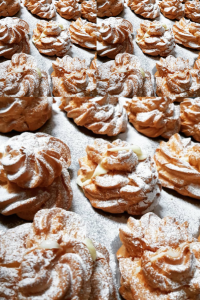Method
Step 1: Make the Dough
In a mixing bowl, combine the flour, sugar, and salt. Add the butter and work it into the dry ingredients using your fingers until it resembles crumbs.
Add the eggs and milk gradually, mixing until a smooth dough forms. Knead for 5–7 minutes until elastic.
Cover the dough with a clean towel and let it rest for 30 minutes.
Step 2: Prepare the Custard
In a saucepan, heat the milk over medium heat until warm but not boiling.
In a separate bowl, whisk together the sugar, cornstarch, and lemon zest. Slowly add the warm milk to this mixture, whisking continuously to avoid lumps.
Return the mixture to the saucepan and cook over low heat, stirring constantly, until it thickens (about 10 minutes). Add the vanilla extract and mix well.
Transfer the custard to a bowl, cover with plastic wrap (touching the surface to prevent a skin from forming), and let it cool to room temperature.
Step 3: Fry the Dough
Roll out the dough into thin sheets (about 1/8 inch thick). Cut into strips or rectangles.
Heat oil in a heavy-bottomed pan to 350°F (175°C). Fry the dough in batches until golden and crisp.
Drain on a cooling rack or paper towels.
Step 4: Assemble the Testa di Turco
In a baking dish, layer the fried dough and custard alternately, starting with a layer of dough.
Finish with a custard layer on top. Cover and let the dish stand in the refrigerator for 2 hours to allow the flavors to meld.
Step 5: Garnish and Serve
Dust the top with powdered sugar and a sprinkle of ground cinnamon. Add chopped pistachios or candied fruit for an authentic Sicilian touch.
Slice and serve chilled.
Tips and Variations
For a lighter version: Bake the dough strips at 375°F (190°C) until golden instead of frying.
Gluten-free option: Use a 1:1 gluten-free flour blend for the dough.
Vegan alternative: Substitute eggs with flax eggs and use plant-based milk for the custard.
Flavor twists: Add a splash of orange blossom water to the custard for a fragrant variation.

